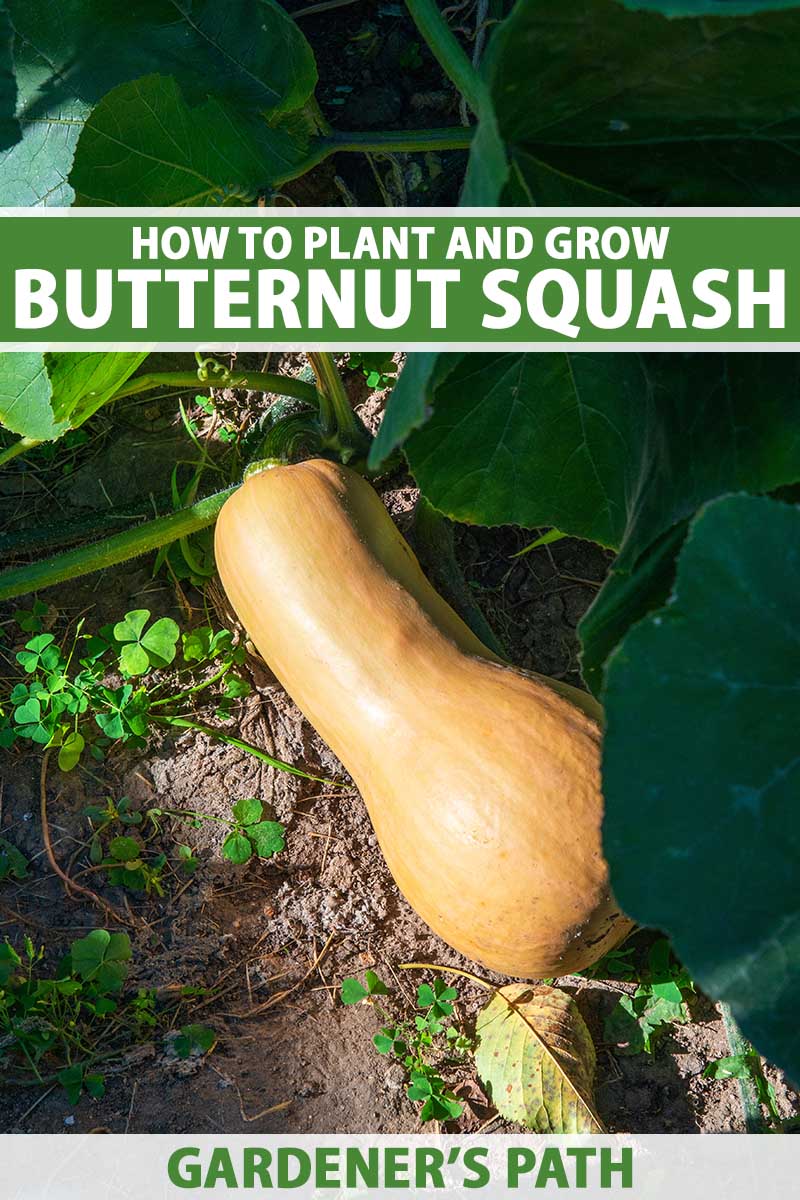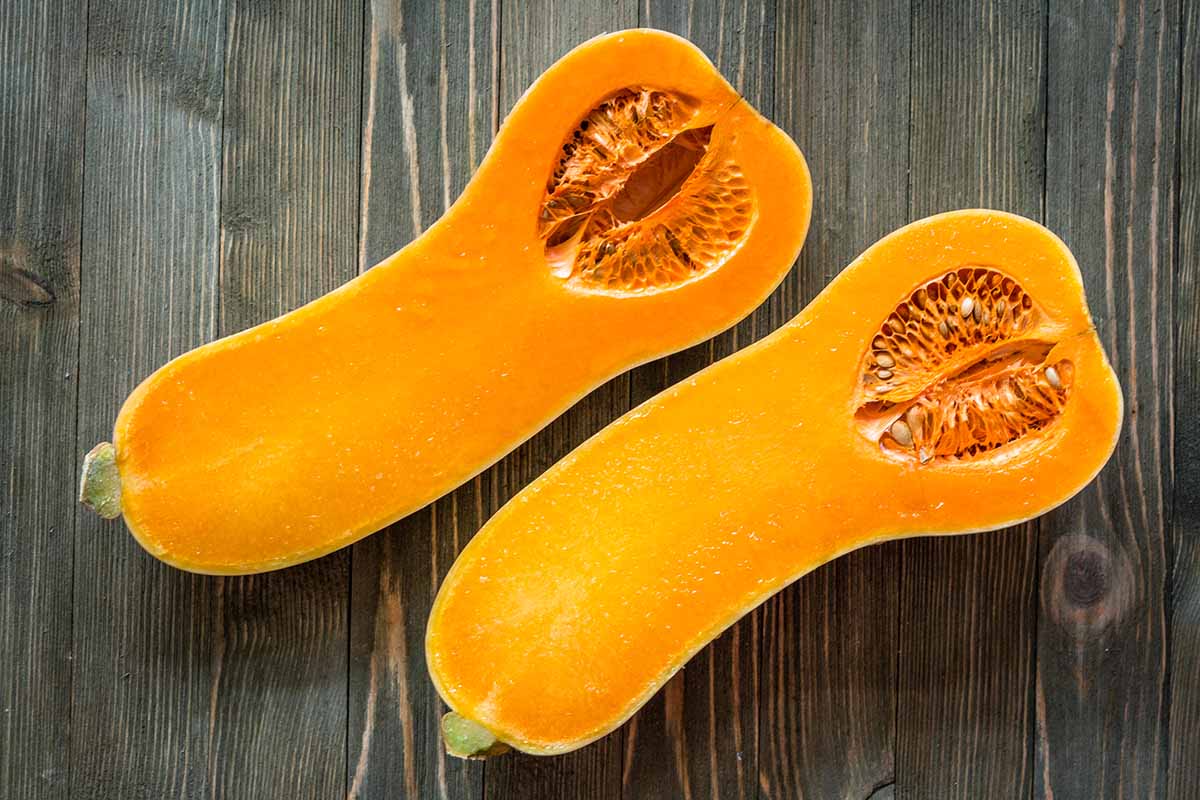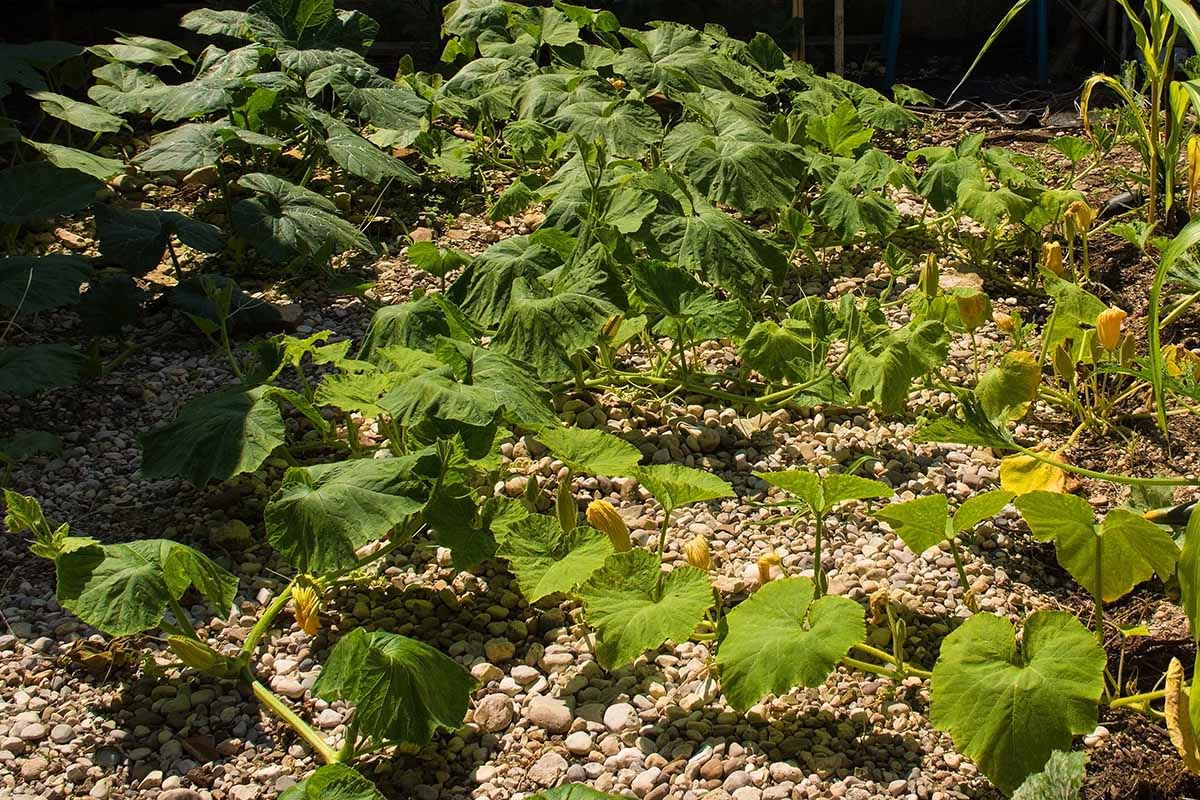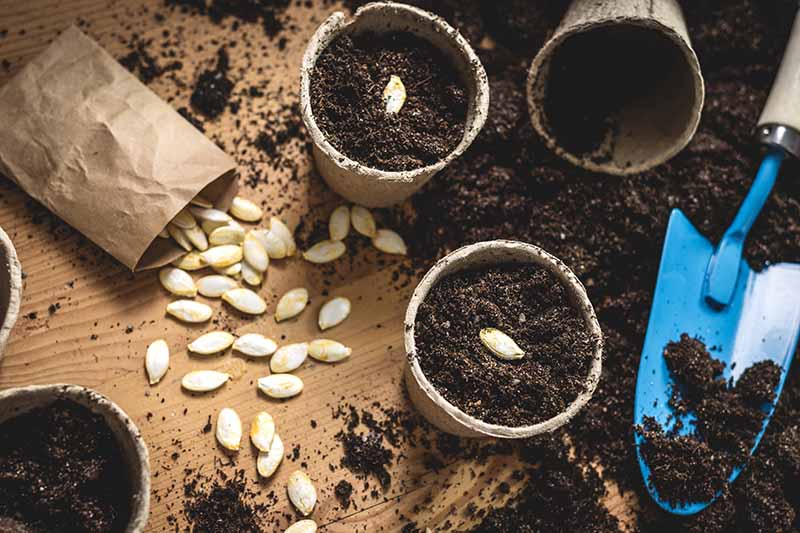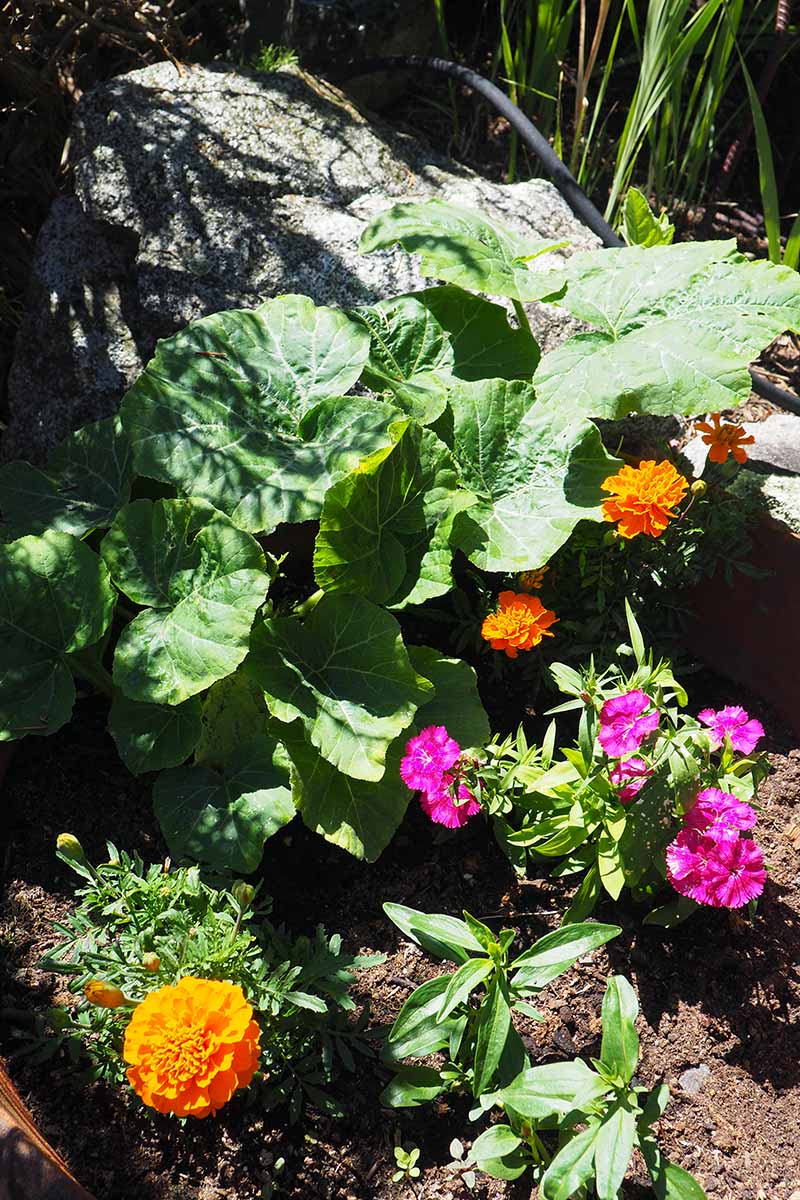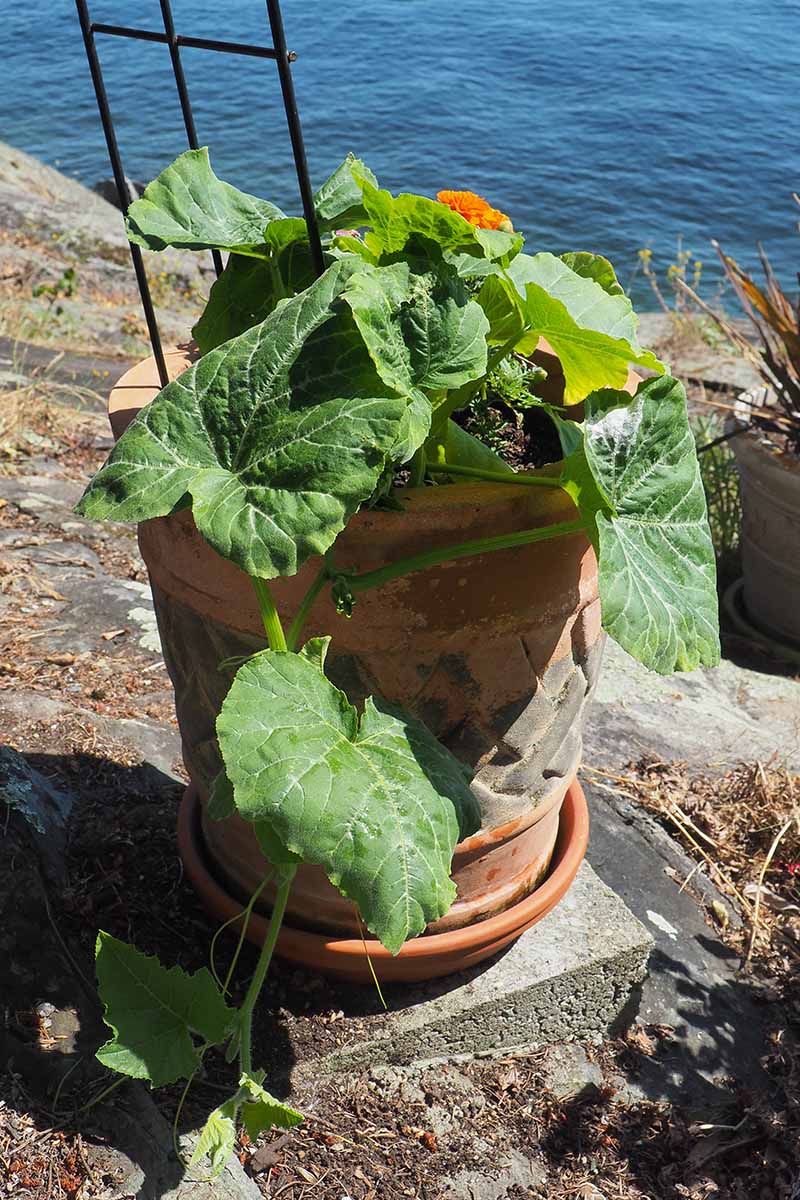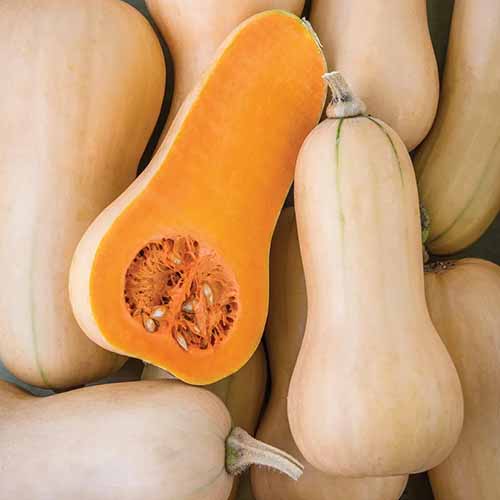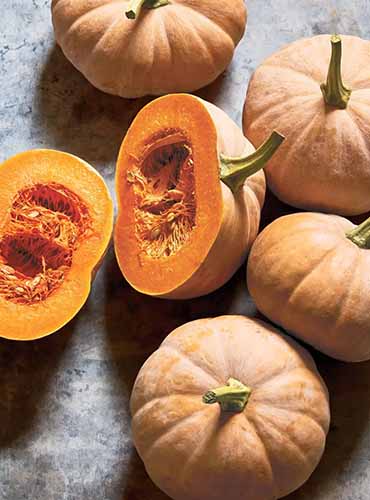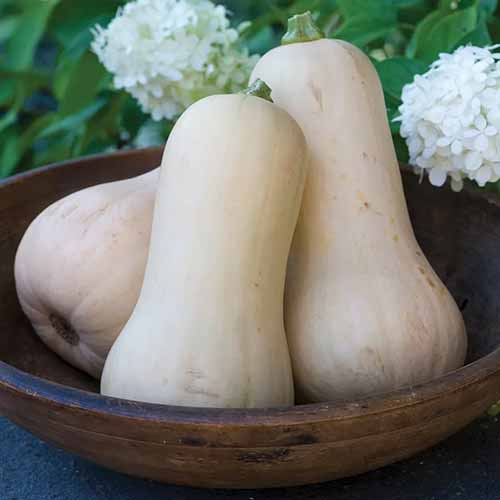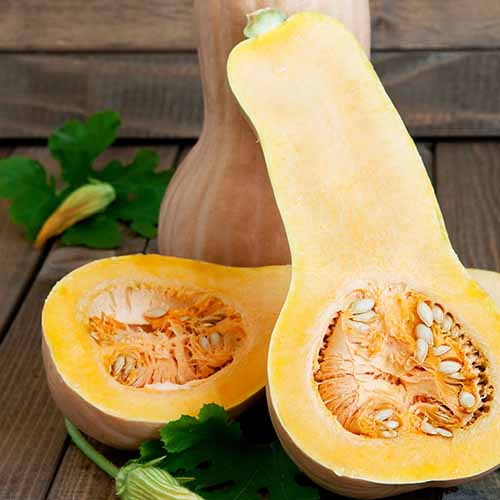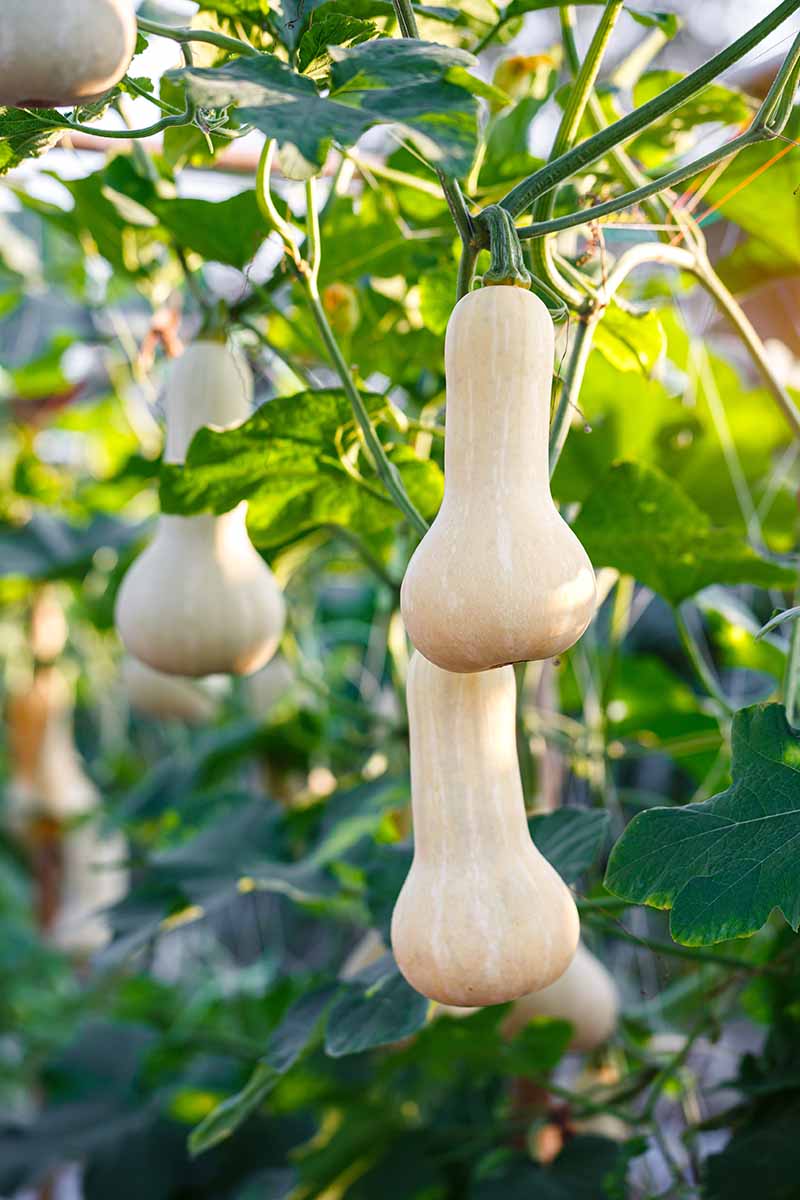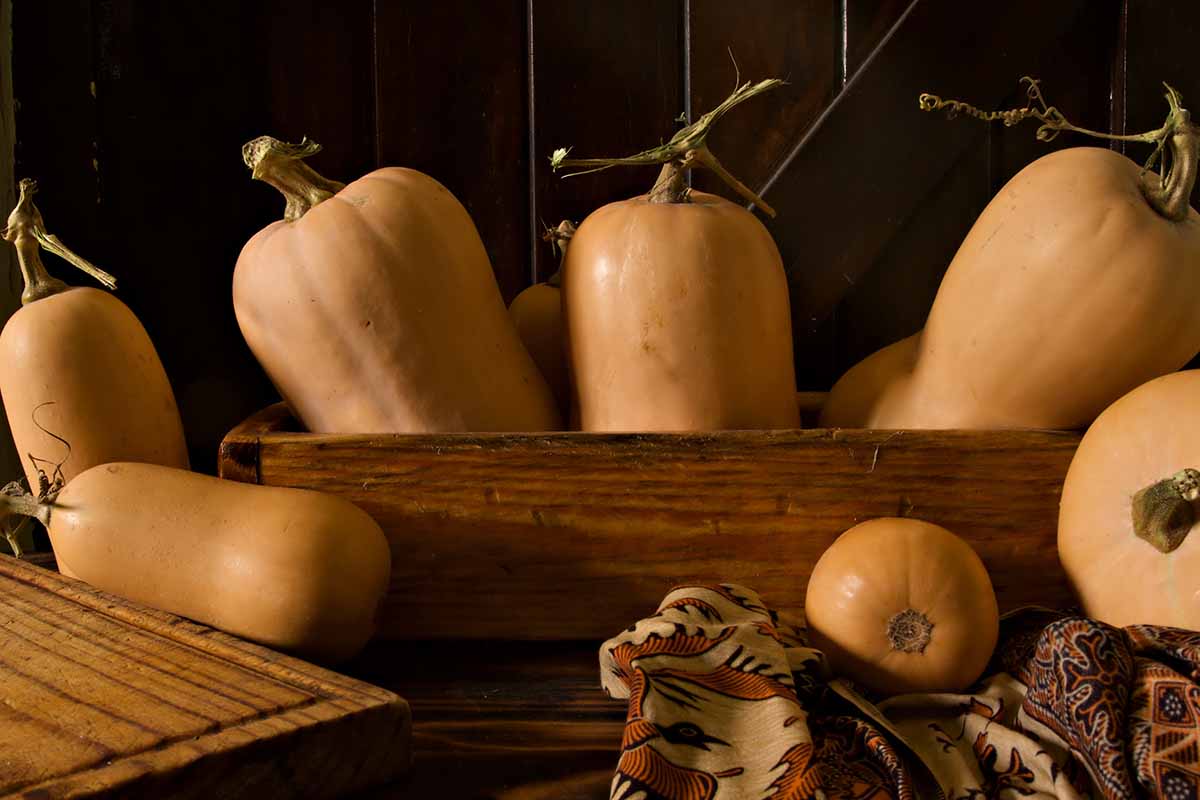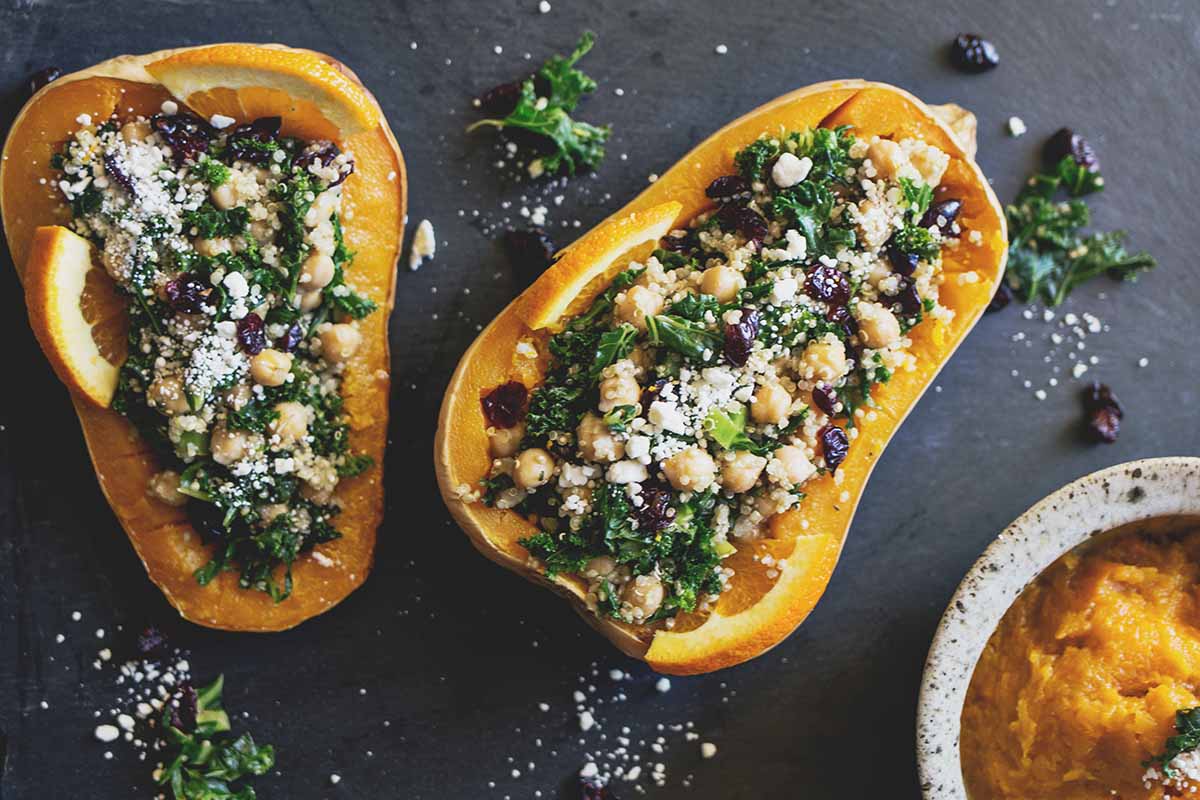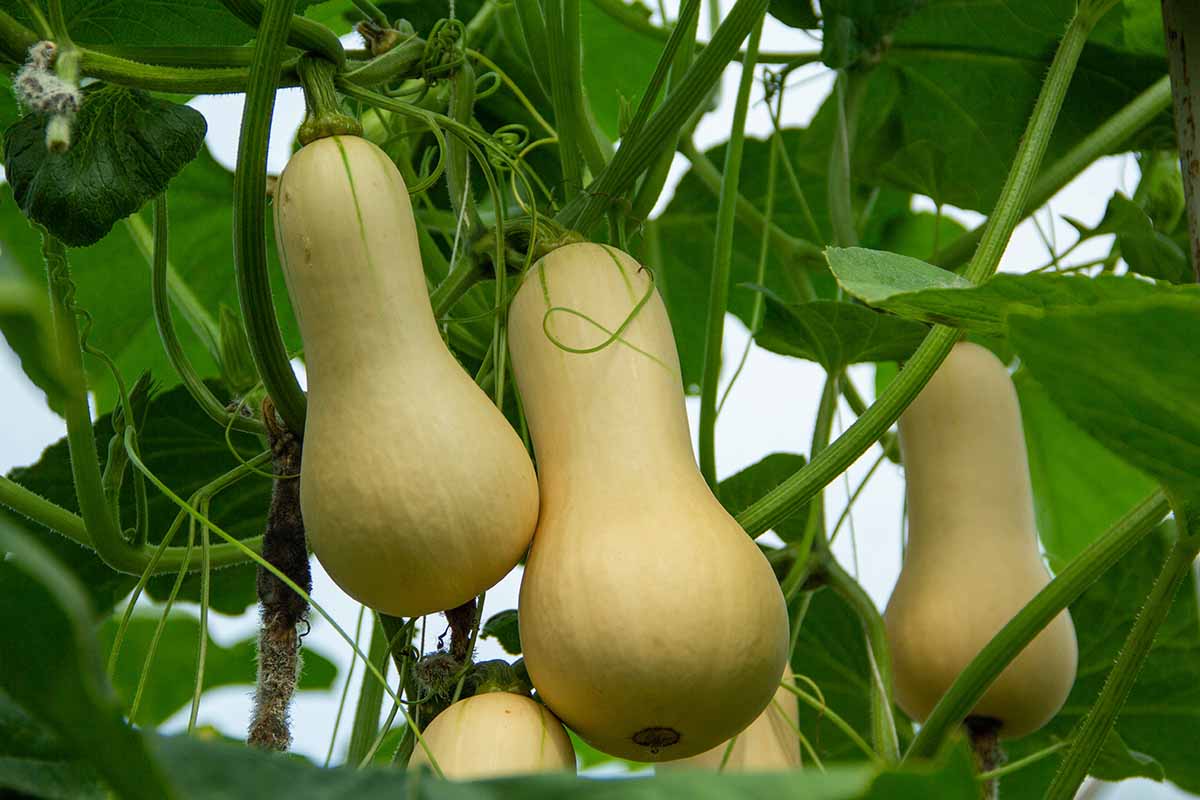We link to vendors to help you find relevant products. If you buy from one of our links, we may earn a commission. Large yellow flowers produce pear-shaped gourds in summer that are harvested in early fall. These are excellent for storing, with a shelf life of two to six months in the right conditions. These warm-weather plants need a long season of heat and toasty temperatures to fully develop the beautiful beige gourds, so starting plants indoors is a good idea in cool or northern climates. Wonderfully versatile in a range of recipes including both savory and sweet dishes, the pretty fruit brightens any table. Plus, these healthy, fiber-rich gourds are an excellent source of vitamins A and C. Pretty, tasty, and nutritious, you’ll love how responsive these plants are when given a little bit of extra attention to meet their needs! Does this sound like a veggie you want to grow? Then join us now to learn how to grow and care for butternut squash. Here’s everything we’ll cover up ahead:
What Is Butternut Squash?
Butternut squash, aka butternut pumpkin or gramma, is a variety of the winter squash species Cucurbita moschata which is in the gourd family, Cucurbitaceae. A creeping or climbing, tendril-bearing annual that trails from five to 15 feet, it produces large, bell-shaped yellow flowers and medium-sized fruit typically in the range of three to five pounds at maturity. Technically, butternuts are fruits. But they’re consumed as a cooked vegetable. The growing season is typically 100 to 120 days with fruits forming in summer, but shorter-season cultivars are available. They have a characteristic hourglass or pear-like shape that features a longish, fleshy neck and bulbous blossom-end bottom that contains the seed cavity. The thick, hard rind is inedible and changes color as it matures, from green to beige or tan when ripe in fall. When raw, the beautiful, deep orange flesh is dense and hard with a slightly acerbic flavor. Cooked, the flavor sweetens and takes on nutty notes with a smooth, velvety texture. Highly nutritious and widely versatile, butternut squash may be used in a range of dishes, both savory and sweet – from creamy soups, stuffed pasta, and grilled wedges to cakes, muffins, and pies. Mature gourds store well and can be kept for two to six months, depending on the variety and storage conditions. We’ll provide storage recommendations later in this guide, so keep reading!
Cultivation and History
Winter squash are native to the Americas and have been a food source for indigenous peoples for millennia. The butternut type is thought to be a natural cross or mutation of the Canada crookneck variety of the same species, which was further developed by amateur breeder Charles A. Leggett. In 1944, Leggett produced the first dependable cultivar with fruit that had a shorter, thicker neck, fewer seeds, and thus, less waste. Leggett was said to have described the flesh of his new fruit as “smooth as butter and sweet as a nut” giving rise to the term “butternut.” Cucurbita is Latin for gourd and moschata is Latin for musky, while the term “squash” is a derivative of the Narragansett Native American word askutasquash. Since the 1940s, several new varieties have been developed including dwarf and bush (non-vining) cultivars such as ‘Butterbush’ and ‘Honeynut.’ We’ll discuss a few options available to home gardeners in more detail below.
Propagation
A warm-season plant, squash seeds can be sown directly into the ground outdoors, or started indoors early and then planted out. To direct sow, plant after all danger of frost has passed and soil temperatures have warmed to at least 65°F. Plant seeds half an inch to one inch deep in hills or mounds, spacing them about six to 12 inches apart. Water lightly but avoid overwatering, which can inhibit germination. Seeds should sprout in five to 10 days. To start indoors, sow seeds four to six weeks before the last predicted frost date. Sow one or two seeds in small, four-inch containers filled with a starter mix. Keep the soil moist but not wet. After sprouting, place potted seedlings under grow lights or in a bright, sunny window, and keep the soil lightly moist. Once seedlings develop their second set of true leaves and all risk of frost has passed, harden them off before transplanting into the garden. Plant them at the same depth as the container they are currently growing in.
How to Grow
Once soil temperatures reach a minimum of 65°F, choose a sunny location in humus-rich, well-draining soil with a slightly acidic pH of 6.0 to 6.8 to grow your transplants. Before planting, create a small hill or mound about 18 inches tall. Hilling is a good method for trailing veggies, as it gives them room to sprawl and helps to improve air circulation to keep plants dry and healthy. An alternative is to train vines onto a sturdy trellis for upright growth. However, this is best for cultivating small fruits that are less than two to three pounds at maturity. Heavier fruits can snap stems and may require a sling and rigging to ease the weight. Sow seeds as described above and provide at least one inch of water per week in the absence of rain to keep the soil moist but not wet. Powdery mildew can be a problem for these plants, which can be offset by keeping the leaves dry. Drip or soaker hoses are excellent for this type of watering, which you can read about in our guide to irrigation methods. Once plants have two true sets of leaves, either after transplanting or for those sown directly in the garden, it’s time to mulch. Give them a two-inch mulch of leaf mold or straw to retain moisture and keep weeds down. Butternuts are heavy feeders and benefit from an application of liquid fertilizer every three to four weeks, until about a month before harvest. Use a balanced formula such as 10-10-10 NPK or a vegetable formula with a lower nitrogen level such as 5-10-10 to prevent unruly foliage growth. In addition to regular fertilizing, you can also side-dress with a two- to four-inch layer of compost or well-rotted manure halfway through the growing season. For container growth, choose pots at least 24 inches tall and wide to allow plants to trail in an airy environment. You can also add a few quick-flowering annuals to attract pollinators. Squash flowers are often hidden under foliage, and they require insects for pollination. To promote good yields, plant alyssum, coreopsis, cosmos, or dill nearby to attract beneficial predators and pollinators to your plants. I like to line the bottom of pots with drainage material such as pebbles or broken pottery. Then fill with humus-rich soil amended with moisture-retentive materials such as coconut coir, peat moss, perlite, or vermiculite. Place in a warm, sunny location and keep the soil moist, but not wet. Feed with a liquid fertilizer every three weeks until the skin of the fruit begins to change color, about a month before harvest. Like other types of squash, it should be noted that butternuts are monoecious, meaning they have distinctive male and female flowers. Male flowers appear first and do not produce fruit. The female flowers appear about five days later and each one has a tiny pre-gourd at the base of the flower stem which develops into a fruit when pollinated.
Growing Tips
The following tips will help ensure a bountiful harvest:
For small gardens, choose space-saving bush or dwarf varieties.Water at the base of plants to avoid wet foliage.Plant in hills or mounds for optimal air circulation and to improve drainage. Large containers work as well if plants are allowed to drape over the edges.Fertilize regularly for consistent, steady growth.Keep soil moist but not wet. Add mulch to help retain moisture.
Maintenance
As fruits grow and ripen, raise them off the soil with small boards, flat stones, or dry straw mulch. This helps to keep the fruit dry and prevents rotting. These sun-lovers can overheat on hot summer afternoons. It’s not unusual for leaves to wilt somewhat in the afternoon, then perk up again as the sun goes down. Should plants not revive, provide them with light afternoon shade. If your area experiences extended periods of heat or drought, you can use shade cloth to protect plants from the afternoon sun. Pruning the vines isn’t absolutely necessary, but it can help the plants to produce higher yields. You can learn more about when and how to do this in our guide to trimming pumpkin vines. And once your plants are harvested, clean and dispose of plant material. If powdery mildew was present during the growing season, avoid putting plant debris in the compost. In moist conditions, slugs and snails may munch on tender seedlings. Handpick and dispose of any gastropods you find attacking your vines.
Butterbush
‘Butterbush’ are compact, tidy plants that yield up to five large fruits each with deep orange, sweet, creamy flesh and a small seed cavity. These store well for up to six months. ‘Butterbush’ An excellent choice for small gardens, the vigorous vines grow up to 12 inches tall and trail four to five feet, producing two- to three-pound fruits in a 75-day growing season. Seeds are available at Burpee.
Butterkin
A unique hybrid cross between a butternut and a pumpkin (C. pepo), ‘Butterkin’ has a rounded shape with a smooth rind of pale, creamy orange and extremely sweet orange flesh. The compact vines reach a height of eight to 10 inches and trail four to six feet with a growing season of 105 days. Fruits reach a mature size of two to four pounds and have a medium seed cavity. ‘Butterkin’ ‘Butterkin’ is quickly gaining popularity for its tidy size, easy growth, and compact, flavorful fruits. You can find packets of seeds available at Burpee.
Honeynut
A recent open-pollinated hybrid from Cornell University, ‘Honeynut’ is a butternut and buttercup (C. maxima) cross with adorable, thick-necked mini-fruits the size of a medium potato. Fruits weigh in at just one-half to one pound each. The firm, moist flesh is exceptionally sweet with nutty tones and a smooth, satiny texture. The amber rinds are streaked with green and somewhat thin-skinned, and the fruit may be stored for up to three months. ‘Honeynut’ Bred with improved resistance to powdery mildew, plants grow 10 to 12 inches tall and trail seven to 10 feet. ‘Honeynut’ has a growing season of 110 days. Conventional and organic seeds in packets and in bulk can be purchased at True Leaf Market.
Pilgrim
Noted for its rich, buttery, nutty flavor, ‘Pilgrim’ features classic pear-shaped fruits with buff-colored rinds, bright orange flesh, thick meaty necks, and a small seed cavity. A dwarf variety, the vines grow eight to 12 inches tall and spread only two to three feet. The three-pound fruits mature in 80 to 90 days. ‘Pilgrim’ Full-flavored and densely fleshed, ‘Pilgrim’ is well-suited for container growth and small garden spaces. Conventional seeds can be purchased at Burpee and organic seeds are available at True Leaf Market.
Waltham
The original butternut hybrid, ‘Waltham’ features long-necked, teardrop-shaped fruits with sweet and tender flesh. The three- to six-pound fruits have a hard, tan-colored rind with a bright marigold-orange interior. Fruits mature in 85 to 95 days on high-yield vines that grow 16 to 36 inches tall and trail six to nine feet. Flavor improves after one to two months of storage and fruits may be stored for up to six months. ‘Waltham’ This is a reliable choice for large containers, hills, and mounded rows. Conventional seeds are available in packets and in bulk at Eden Brothers. Organic ‘Waltham’ seeds are available from Gurney’s via Home Depot.
Managing Pests and Disease
The most common pest you may come across is the squash bug (Anasa tristis), a sap-sucker that attacks leaves and stems. Use a hose or knock adult bugs off plants and into a bucket of soapy water. Destroy any of the reddish eggs you find on the underside of leaves. Squash bugs can also be trapped under a board overnight and then disposed of in the morning. The dreaded squash vine borer usually doesn’t attack butternuts, according to experts at the University of Minnesota Extension program. But plants are susceptible to the fungal infections such as powdery mildew, which appears as a white or gray dusting on leaves. Affected foliage should be removed and destroyed. Infected plants may need to be sprayed with a fungicide such as neem oil to prevent further spread. Adequate air circulation is the best prevention for powdery mildew, so ensure plants have ample spacing and clean up plant debris in fall to prevent spores from overwintering.
Harvesting
Butternuts are ready for harvest when the rinds have hardened and turned from green to a warm tan. Using a clean, sharp knife, cut through the stem about two inches from the fruit. Leaving the stem attached helps prevent unwelcome bacteria from entering through the soft spot where the stem is attached. After picking, the fruit needs to cure for a few weeks to help harden the rind for storage and to improve its flavor. Gently wash the fruit then lay it out on a drying rack or shelf to cure in a warm, dry location with a temperature around 70°F. Cure for four weeks, turning the fruit over halfway through the curing period.
Storage
After curing, store fruits in one or two layers in baskets or bins for three to six months in a cool, dry location with temperatures around 40 to 50°F. A basement or cellar works fine, but don’t let the gourds freeze. To harvest seeds for propagation next year, open a gourd and remove the seeds and surrounding membrane. Wash the seeds thoroughly then lay them out in a single layer on a paper towel to dry in a warm, dry area out of direct sunlight. When dry in seven to 10 days, package in an envelope and store in a cool, dry cupboard. Dried seeds will remain viable for up to six years in these conditions. Peeled and cubed fruit can be stored in the refrigerator in an airtight container for up to five days.
Preserving
Flash-freeze peeled and cubed fruit in a single layer on a baking sheet until the cubes are frozen, in one to two hours. Package frozen cubes into airtight containers and freeze for six to 12 months. Peeled and cubed fruit can also be canned. Blanch it first for two minutes in boiling water then pack into clean, sterile canning jars. Add two teaspoons of lemon juice per pint of fruit. Top the jars with the blanching liquid, leaving half an inch of headspace. Place clean, sterile lids on the jars and screw bands on lightly. Process in a pressure canner at 10 pounds of pressure for 55 minutes for pints and 90 minutes for quart jars. Unopened canned squash can be stored for two to five years in a cool, dark cupboard.
Recipes and Cooking Ideas
A traditional winter vegetable, the delicious flavor of butternut squash can be enjoyed at any time of the year. It’s a treat on the summer grill, as well as in roasted vegetable medleys, soups, salads, and risotto. You can find several delicious and satisfying recipes from biscuits to soups and stews in this roundup of 15 of the best butternut squash recipes from our sister site, Foodal. In short-summer areas, start seeds indoors for the most productive vines and plant out where they’ll have plenty of space to grow. Remember to cure the fruits before storing, then enjoy your harvest in dozens of different recipes! Do you folks have a favorite cultivar to grow? Tell us about it in the comments section below. And for even more information about growing winter squash, have a read of these guides next:
The Complete Guide to Growing Winter SquashHow to Plant and Grow Spaghetti SquashHow to Grow Your Own Pumpkins
